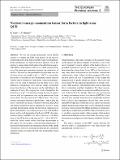Please use this identifier to cite or link to this item:
http://hdl.handle.net/11547/11864| Title: | Nucleon's energy-momentum tensor form factors in light-cone QCD |
| Authors: | . Azizi, K |
| Issue Date: | 2020 |
| Abstract: | We use the energy-momentum tensor (EMT) current to compute the EMT form factors of the nucleon in the framework of the light cone QCD sum rule formalism. In the calculations, we employ the most general form of the nucleon's interpolating field and use the distribution amplitudes (DAs) of the nucleon with two sets of the numerical values of the main input parameters entering the expressions of the DAs. The directly obtained results from the sum rules for the form factors are reliable at Q(2)>= 1 GeV2: to extrapolate the results to include the zero momentum transfer squared with the aim of estimation of the related static physical quantities, we use some fit functions for the form factors. The numerical computations show that the energy-momentum tensor form factors of the nucleon can be well fitted to the multipole fit form. We compare the results obtained for the form factors at Q(2)=0 with the existing theoretical predictions as well as experimental data on the gravitational form factor d(1)(q)(0). For the form factors M-2(q)(0) and J(q)(0) a consistency among the theoretical predictions is seen within the errors: our results are nicely consistent with the Lattice QCD and chiral perturbation theory predictions. However, there are large discrepancies among the theoretical predictions on d(1)(q)(0). Nevertheless, our prediction is in accord with the JLab data as well as with the results of the Lattice QCD, chiral perturbation theory and KM15-fit. Our fit functions well define most of the JLab data in the interval Q(2)is an element of[0,0.4] GeV2, while the Lattice results suffer from large uncertainties in this region. As a by-product, some mechanical properties of the nucleon like the pressure and energy density at the center of nucleon as well as its mechanical radius are also calculated and their results are compared with other existing theoretical predictions. |
| URI: | http://hdl.handle.net/11547/11864 |
| ISSN: | 1434-6044 |
| Appears in Collections: | Web Of Science |
Files in This Item:
| File | Description | Size | Format | |
|---|---|---|---|---|
| s10052-020-7676-5.pdf | 525.35 kB | Adobe PDF |  View/Open |
Items in DSpace are protected by copyright, with all rights reserved, unless otherwise indicated.
